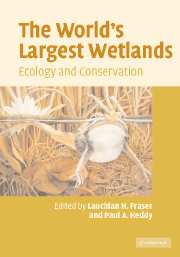Book contents
- Frontmatter
- Contents
- List of contributors
- Preface
- 1 Introduction: big is beautiful
- 2 The West Siberian Lowland
- 3 The Amazon River basin
- 4 The Hudson Bay Lowland
- 5 The Congo River basin
- 6 The Mackenzie River basin
- 7 The Pantanal
- 8 The Mississippi River alluvial plain
- 9 The Lake Chad basin
- 10 The River Nile basin
- 11 The prairie potholes of North America
- 12 The Magellanic moorland
- 13 The future of large wetlands: a global perspective
- Index
- References
7 - The Pantanal
Published online by Cambridge University Press: 10 August 2009
- Frontmatter
- Contents
- List of contributors
- Preface
- 1 Introduction: big is beautiful
- 2 The West Siberian Lowland
- 3 The Amazon River basin
- 4 The Hudson Bay Lowland
- 5 The Congo River basin
- 6 The Mackenzie River basin
- 7 The Pantanal
- 8 The Mississippi River alluvial plain
- 9 The Lake Chad basin
- 10 The River Nile basin
- 11 The prairie potholes of North America
- 12 The Magellanic moorland
- 13 The future of large wetlands: a global perspective
- Index
- References
Summary
The Pantanal is a savanna wetland which, because of its wildlife, is recognized as one of the most important freshwater systems in the world. It is fed by tributaries of the upper Paraguay River in the center of South America, mainly in Brazil. The north–south gradient in flood level creates a range of major habitats in a complex mosaic with annual seasonality. The rivers and streams are lined with gallery forests, and other arboreal habitats exist in the more-elevated areas. The remainder is either grasslands or seasonally flooded grasslands. The flora and fauna are related to the Cerrado biome of central Brazil, with the Amazonian influence contributing great species diversity. The vegetation is composed of 1863 phanerogam plant species listed for the floodplain and 3400 for the whole basin. The complex vegetation cover and the seasonal productivity support a diverse and abundant fauna. Many endangered species occur here, including the jaguar (Panthera onca). Waterfowl are exceptionally abundant during the dry season. Deforestation of dense savanna and strips of forest has increased dramatically, with subsequent erosion. Another threat is unsustainable agricultural and cattle-ranching practices, which convert the natural vegetation into pastures and soybean plantations, especially on the surrounding plateaus. Fires caused by humans are severe and have become part of the annual cycle for ranch owners. Despite the natural exuberance, the lack of infrastructure and poor utilization of touristic potential constitute the main obstacles to carrying out sustainable conservation.
- Type
- Chapter
- Information
- The World's Largest WetlandsEcology and Conservation, pp. 203 - 271Publisher: Cambridge University PressPrint publication year: 2005
References
- 2
- Cited by

